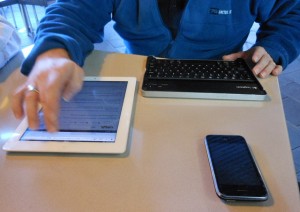
 As the world plods onto bigger, greener and higher tech pastures, one would assume that every industry would go right along with it. The public release of the Internet heralded the downfall of some, such as video rental stores and travel agencies. Those that survived have generally embraced mobile technology, with iPads replacing mechanical cash registers in some establishments. However, for others, this process has been slower to catch on or is entirely non-existent.
As the world plods onto bigger, greener and higher tech pastures, one would assume that every industry would go right along with it. The public release of the Internet heralded the downfall of some, such as video rental stores and travel agencies. Those that survived have generally embraced mobile technology, with iPads replacing mechanical cash registers in some establishments. However, for others, this process has been slower to catch on or is entirely non-existent.
For those who are considering whether or not to integrate mobile technology into your business, consider if it will help or hinder operations. Below are examples of varying levels of success to integrate technology within different industries.
As mentioned earlier, many retailers are trading in their old, archaic cash registers for an iPad as their point of sale. Apps like Vend Register POS and Xero can handle everything from sales to finance tracking. These programs also save on paper waste that is generated from paper-loaded cash registers and are able to share transaction history with banks, saving store owners multiple trips to the bank for deposits.
Further, technology has had a positive impact on business intelligence, allowing companies to track their performance and set goals through easy-to-read dashboards. Using these dashboards also saves on storage space by reducing paper waste.
Technological integration in a retail environment seems like a given considering the benefits and ease of use, but store owners also need to be mindful of the various monthly and per-transaction fees that come with a debit/credit system. For businesses operating on a deficit, sticking with a traditional POS system may be the best way to avoid unnecessary fees.
With the vast number of technological advancements in the field of medicine over the last 100 years, you’d think that nurses using something as seemingly innocuous as a tablet or other PDA would seem commonplace. Surprisingly, even though there are a number of reference apps targeted towards nurses, their full adoption has been slow to catch on.
But why is that? Because nurses are forgetting to plug it in after a long shift. A study conducted by Bradley University found that even though they find using a PDA useful for quick reference and time management, something as simple as not knowing how to use it and remembering to plug it in are quickly making PDAs seem like a useless addition to an already over-utilized workforce.
Were a healthcare setting to adopt PDAs to help nurses with everyday tasks, there would need to be a continuous chain of PDAs available that are charged on a rotational basis. Considering nurses need functional equipment and information on the fly, the full adoption of PDAs may still be a ways off.
 Much like retailers, restaurants have also benefited from reduced paper waste through technological advances. Order screens, performance metrics, and inventory tracking software have replaced archaic order pads and boxed records. Much of a restaurant’s data can be replicated paperlessly and made readily accessible through proprietary software.
Much like retailers, restaurants have also benefited from reduced paper waste through technological advances. Order screens, performance metrics, and inventory tracking software have replaced archaic order pads and boxed records. Much of a restaurant’s data can be replicated paperlessly and made readily accessible through proprietary software.
Though recently discovered to be a risky industry, some restaurants have experienced success with integrating technology into their overall vision. Bryn & Dane’s is a restaurant chain that sells “healthy fast food”. Through self-0rder solutions and a strong social media presence, Bryn & Dane’s is expanding their operations into 2015 in a troubled industry.
However, one consideration that needs to be taken into account would be whether or not the restaurant generates enough traffic to justify startup and recurring costs. If a restaurant is not generating enough income or even working on a deficit, it may make more sense to stay with their existing model, unless the reason behind the deficit is directly related to an archaic system or approach.
A part of any successful business plan is a thorough SWOT, or Strengths, Weaknesses, Opportunities and Threats, analysis, and technological integration needs to be carefully considered. Does your operation generate enough revenue to cover the cost of equipment within a reasonable amount of time? Are the inherent benefits of said technology outweigh the cost?
A “mom & pop” hot springs in rural Idaho may not necessarily need an in-depth POS system to conduct business, but an establishment that has no idea which end is up may benefit from the short-term costs in order to increase their profit.
image credit: Michael Coghlan
Wait! Before you go.
Choose how you want the latest innovation content delivered to you:
 Robert Conrad is a former manager/trainer who has received multiple accolades throughout his career. These include invitations to company focus meetings and a handcrafted plaque presented to him by his team. Now, he is a mentor for at-risk youth and even cooks at a local detention facility. In his off-time, he enjoys playing video games and spending time with his family. Follow Robert on Twitter and Facebook.
Robert Conrad is a former manager/trainer who has received multiple accolades throughout his career. These include invitations to company focus meetings and a handcrafted plaque presented to him by his team. Now, he is a mentor for at-risk youth and even cooks at a local detention facility. In his off-time, he enjoys playing video games and spending time with his family. Follow Robert on Twitter and Facebook.





